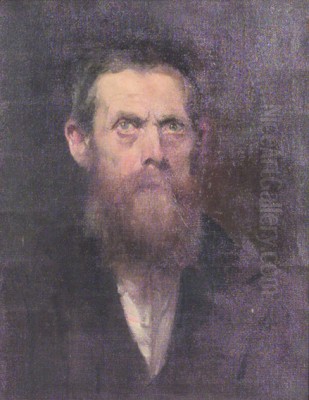
Eugen von Blaas, also known during his lifetime as Eugene de Blaas, stands as a significant figure in late 19th and early 20th-century European art. An artist of Italian birth and Austrian heritage, he dedicated his considerable talents to capturing the vibrant life and picturesque beauty of Venice. Working firmly within the Academic Classicism tradition, Blaas became renowned for his meticulously detailed and colourfully rendered genre scenes and portraits, offering a romanticized yet engaging glimpse into the daily lives of Venetians. His work, popular during his lifetime and enduringly appealing, provides a fascinating window into a specific moment in art history, one where traditional techniques met charming, everyday subjects.
Early Life and Artistic Heritage
Eugen von Blaas was born on July 24, 1843, in Albano, a town near Rome, Italy. Although born on Italian soil, his parentage was Austrian. His father, Karl von Blaas (1815-1894), was a distinguished artist in his own right – a painter of historical scenes, portraits, and large-scale murals, associated with the Nazarene movement in his youth and later a prominent figure in Austrian Academic art. Karl held prestigious positions, including a professorship at the Academy of Fine Arts in Vienna and later at the Venice Academy. This familial connection provided Eugen with an immersive artistic environment from his earliest years.
The influence of Karl von Blaas on his son's development cannot be overstated. Eugen received his initial artistic training directly from his father, absorbing the principles of Academic draftsmanship, composition, and the importance of historical accuracy and technical polish. The family's artistic inclinations extended further; Eugen's younger brother, Julius von Blaas (1845-1923), also became a successful painter, specializing primarily in animal subjects, particularly horses, and military scenes, eventually also teaching at the Vienna Academy. This artistic dynasty ensured Eugen was steeped in the traditions and expectations of the established art world.
Academic Training and Formation
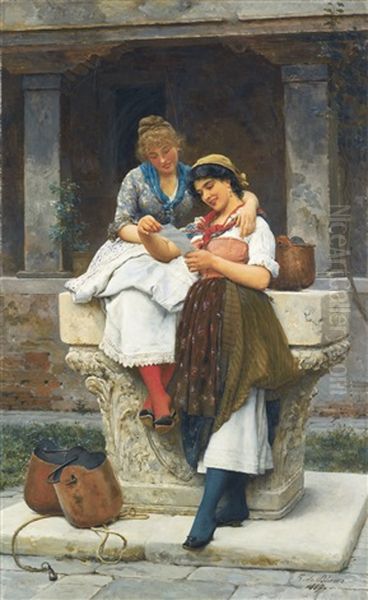
Building upon the foundation laid by his father, Eugen von Blaas pursued formal art education at several prestigious institutions. He studied at the Accademia di Belle Arti in Venice, where his father taught for a period. His training also took him to the art centers of Rome and Vienna, further solidifying his commitment to the Academic style. This rigorous education emphasized classical ideals, anatomical precision, the skillful rendering of textures and fabrics, and the creation of balanced, harmonious compositions.
Unlike many of his contemporaries who would soon break away towards Impressionism, Post-Impressionism, or Symbolism, Blaas remained deeply rooted in the Academic tradition throughout his career. His training equipped him with exceptional technical proficiency, which became a hallmark of his work. He mastered the art of oil painting, achieving smooth finishes, luminous colour, and an almost photographic attention to detail, all while imbuing his subjects with a certain idealized grace.
Venice: The Heart of His Art
While his training spanned several cities, it was Venice that truly captured Eugen von Blaas's artistic imagination and became his adopted home and primary subject. After his family moved there when his father took up a professorship, Eugen eventually settled permanently in the city on the lagoon. From then on, the unique character, inhabitants, and atmosphere of Venice would dominate his oeuvre. He became one of the foremost painters chronicling Venetian life during his era.
Blaas was fascinated by the everyday occurrences and the diverse social fabric of the city. His canvases depict bustling squares (campielli), quiet canals, sun-drenched balconies, intimate domestic interiors, and the working lives of ordinary Venetians. He captured the specific light of Venice, the textures of weathered stone and plaster, the shimmer of water, and the vibrant colours of local costume and market wares. His Venice is often picturesque and charming, reflecting a view popular with both locals and the increasing number of tourists visiting the city.
The Academic Style of Eugen von Blaas
Eugen von Blaas worked squarely within the tradition of Academic Classicism. This style, dominant in European art academies throughout much of the 19th century, emphasized adherence to established rules of composition, idealized forms derived from classical art, historical or mythological subject matter, and a high degree of technical finish. While Blaas focused more on genre scenes than historical epics, his approach remained fundamentally Academic.
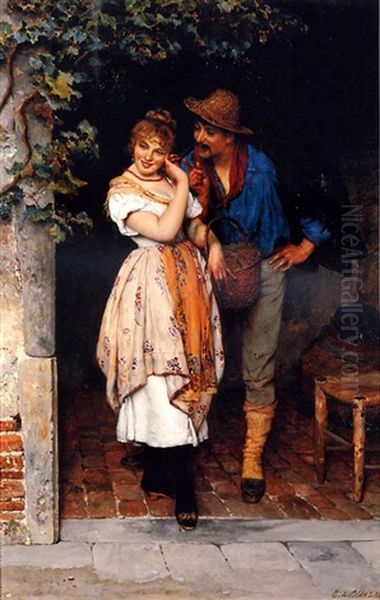
His paintings are characterized by meticulous draftsmanship, a smooth, polished surface that minimizes visible brushstrokes, and a rich, often jewel-like colour palette. He paid extraordinary attention to detail, rendering fabrics, flowers, architectural elements, and human features with remarkable precision. Figures are typically well-defined, anatomically correct, and often possess an idealized beauty, conforming to classical standards. His compositions are carefully constructed, balanced, and easily readable, designed to tell a story or present a scene clearly and effectively. This approach contrasted sharply with the looser brushwork, focus on fleeting light effects, and everyday realism (often less idealized) of the Impressionists like Claude Monet or Pierre-Auguste Renoir.
Capturing Venetian Life: Genre Scenes
The core of Eugen von Blaas's output consists of genre paintings depicting the daily life of Venice. He moved away from the grand historical themes often favoured by Academic painters like his father or French contemporaries such as Jean-Léon Gérôme, choosing instead to focus on more intimate, anecdotal scenes. His subjects were the common people of Venice: fishermen mending nets, women fetching water or selling flowers, gondoliers relaxing, families interacting in courtyards, and social gatherings in small squares.
These scenes are often imbued with a sense of charm, gentle humour, or lighthearted flirtation. Blaas excelled at creating narrative vignettes, capturing moments of interaction and emotion. His works often tell a simple story – a shared glance, a whispered secret, a moment of contemplation, the bustle of a market day. He shared this interest in Venetian folk life with other Italian artists of the period, such as Giacomo Favretto (1849-1887), who also depicted colourful scenes of contemporary Venice, though often with a slightly looser, more painterly technique. Blaas's detailed realism, however, set his work apart.
The Women of Blaas's Venice
A particularly prominent theme throughout Eugen von Blaas's work is the depiction of Venetian women. He painted women from various walks of life, from humble fisherwomen and flower sellers with sun-kissed skin and simple attire to more elegantly dressed ladies of the bourgeoisie. Regardless of social standing, his female figures are almost invariably portrayed with a notable degree of beauty, grace, and vitality. They are often the central focus of his compositions, depicted engaged in daily tasks, quiet moments of reflection, or playful social interactions.
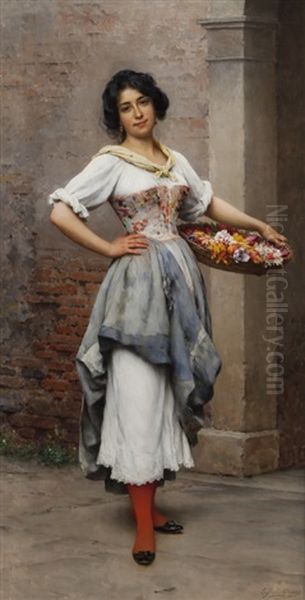
Blaas seemed particularly interested in capturing expressions and gestures that convey personality and emotion, often depicting flirtatious exchanges or moments of coquetry. His rendering of female beauty aligns with 19th-century ideals – clear complexions, lustrous hair, and graceful postures. The attention lavished on their colourful costumes, jewellery, and accessories adds to the visual richness of his paintings. While highly idealized, these portrayals contributed significantly to his popularity. This focus on idealized female beauty finds parallels in the work of other highly successful Academic painters like the Frenchman William-Adolphe Bouguereau, although Blaas situated his subjects within specific, recognizable Venetian settings.
Signature Works
Several paintings stand out as representative of Eugen von Blaas's style and thematic concerns:
The Wedding in the Sacristy (La Forma del Nuziale in Sacrestia): This work exemplifies his skill in depicting group scenes and ceremonial occasions within a detailed architectural setting. It likely captures the signing of marriage documents, showcasing various figures in traditional attire, rendered with his characteristic precision and attention to social ritual.
The Lottery in a Small Venetian Square (La Tombola in Campiello a Venezia): A lively scene capturing the excitement and social interaction of a public lottery drawing, a common event in Venice. Blaas fills the canvas with numerous figures, diverse expressions, and colourful details, creating a vibrant snapshot of community life.
Scene on a Balcony (1877): Typical of his many depictions of figures, often women, on Venetian balconies overlooking canals or squares. These works often feature interactions, moments of observation, or quiet contemplation, framed by flowers and architectural details, showcasing his skill in rendering light and atmosphere.
Portrait of a Young Venetian Girl (1885): Demonstrates his abilities in portraiture, capturing the direct gaze and youthful beauty of the sitter. Even in portraits, his attention to detail in costume and features is evident, often presented with a warm, engaging quality.
The Love Letter, Stolen Kiss, and The Suitor: These titles represent a recurring theme in Blaas's work – romantic and flirtatious encounters. Such paintings often depict charming, anecdotal moments between men and women, highlighting stolen glances, secret messages, and courtship rituals, all rendered with his polished technique and appealing sentiment. These works were particularly popular with collectors.
Exhibitions and International Recognition
Eugen von Blaas achieved considerable success and recognition during his lifetime. He exhibited regularly in Venice, but his reputation extended far beyond Italy. He frequently showed his work in London, participating in exhibitions at the prestigious Royal Academy of Arts, as well as the Grosvenor Gallery and the New Gallery. His paintings found favour with British audiences and collectors, drawn to the romantic allure of Venice and the artist's accessible, highly finished style.
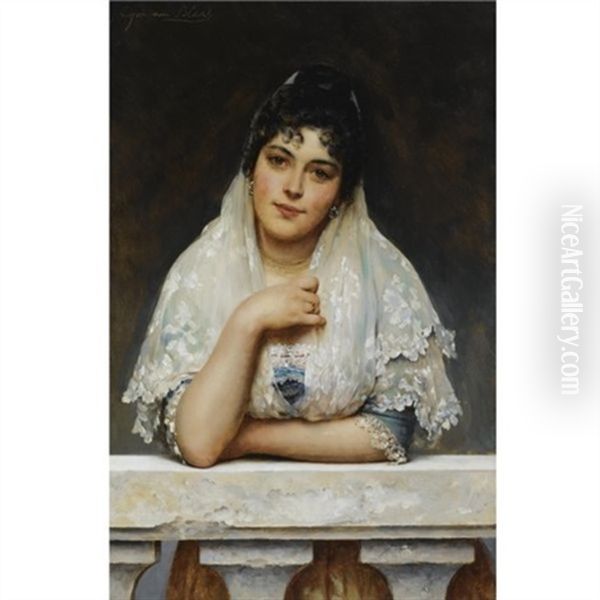
His work was also exhibited in other major European cities, including Vienna and Munich, and even reached audiences further afield in places like Melbourne and Sydney, Australia. The popularity of his Venetian scenes, particularly among tourists visiting Italy, made his paintings desirable souvenirs and decorative pieces for affluent homes in Britain, America, and elsewhere. His success can be compared to that of artists like the Dutch-born British painter Lawrence Alma-Tadema, who similarly achieved immense popularity with meticulously detailed scenes of classical antiquity.
Contemporaries and Artistic Milieu
Eugen von Blaas operated within a rich artistic context. His most immediate connections were his father, Karl, and brother, Julius, forming an artistic dynasty rooted in Academic tradition. He maintained friendships and professional associations within the Venetian art scene, including with fellow artists like Ludwig Passini (1832-1903), an Austrian painter and printmaker also known for genre scenes, who was described as a friend and colleague. He also worked alongside Italian contemporaries focused on Venetian themes, such as Antonio Ermolao Paoletti (1834-1912) and Antonio Rotta (1828-1903).
Beyond his immediate circle, Blaas's career unfolded against the backdrop of major shifts in the art world. While he remained faithful to Academicism, movements like Impressionism, Post-Impressionism, and Symbolism were gaining momentum. His detailed realism and charming subject matter offered a stark contrast to the experimental techniques and often challenging themes explored by the avant-garde. His work can be seen as continuing a long tradition of depicting Venice, stretching back to masters like Canaletto (Giovanni Antonio Canal, 1697-1768) and Francesco Guardi (1712-1793), albeit focusing on human life rather than purely architectural views (vedute). His style also resonates with the broader European phenomenon of highly finished genre painting popular in the Victorian era, exemplified by artists like John William Waterhouse in England, though Waterhouse drew more on Pre-Raphaelite and mythological themes.
Blaas and the Vienna Secession: A Study in Contrast
It is important to distinguish Eugen von Blaas's artistic position from that of the Vienna Secession, a movement that emerged in Austria during the later part of his career (founded in 1897). The Vienna Secession represented a radical break from the very Academic traditions that Blaas upheld. Led by artists such as Gustav Klimt (1862-1918) and architects/designers like Josef Hoffmann (1870-1956), the Secessionists rejected the historical styles and conservative attitudes of the official Vienna Künstlerhaus (the established artists' association).
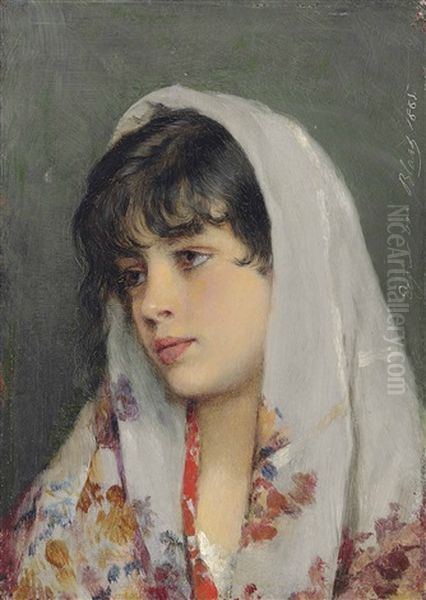
The Secessionists championed modern art, stylistic innovation, the integration of art and craft (Gesamtkunstwerk), and a new, often decorative or symbolic, visual language (Jugendstil/Art Nouveau). Their goals were fundamentally opposed to the principles guiding Eugen von Blaas's work. Blaas, with his roots firmly planted in the teachings of the Vienna Academy (via his father and his own studies) and his consistent adherence to representational accuracy and traditional techniques, represented the establishment that the Secessionists were rebelling against. There is no indication that Blaas had any involvement with or sympathy for the Vienna Secession; his artistic path remained steadfastly Academic.
Legacy and Appreciation
Eugen von Blaas lived a long life, passing away in his beloved Venice on February 10, 1932, at the age of 88. He left behind a substantial body of work that continues to charm viewers with its technical brilliance and idealized depictions of Venetian life. For much of the 20th century, as Modernism dominated art historical narratives, Academic painters like Blaas were often overlooked or dismissed as conservative and overly sentimental. However, in recent decades, there has been a renewed interest in and appreciation for 19th-century Academic art.
Today, Blaas is recognized for his exceptional skill as a draftsman and colourist and for his role in documenting, albeit through a romanticized lens, the customs, costumes, and atmosphere of Venice at a particular point in time. His paintings remain popular on the art market and are held in numerous private collections and public museums around the world. They offer accessible, visually delightful images that celebrate beauty, human interaction, and the enduring allure of Venice. While not an innovator in the modernist sense, Eugen von Blaas perfected a particular vision within the Academic tradition, creating a legacy as one of the most skilled and appealing chroniclers of Venetian genre painting.
Conclusion
Eugen von Blaas carved a distinct niche for himself in the art world of the late 19th and early 20th centuries. As a master of Academic technique, he applied his skills not to grand historical narratives but to the intimate, everyday life of Venice. His paintings, characterized by meticulous detail, vibrant colour, and idealized figures, captured the charm and beauty of the city and its inhabitants. Deeply influenced by his artistic family and rigorous Academic training, he remained committed to this style throughout his long career, achieving significant international recognition. Though distinct from the rising tide of Modernism, his work endures as a testament to his technical prowess and his affectionate portrayal of Venetian life, securing his place as a significant figure in European genre painting.